Apples - Malus domestica
Coddling Moths Damage Stone Fruits
Apple Pests & Diseases
The ABC of Growing Healthy Microgreens at Home
Growing microgreens at home
Chlorophytum saundersiae has won the hearts of gardeners worldwide
Watergras, Weeping Anthericum - Chlorophytum saundersiae
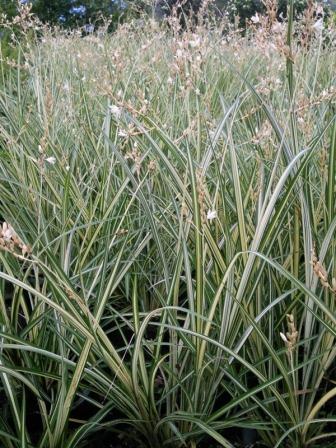 Chlorophytum saundersiae 'Starlight' Picture courtesy Leafs NurseryChlorophytum saundersiae is a popular garden plant because it is hardy, grows in sun or shade, and also in dry or wet beds. Its pleasing grass-like appearance lends itself to any garden style and colour scheme, and it blends in effortlessly with other garden plants. Learn how cultivate healthy specimens, and ways to use them in the landscape for the greatest impact.
Chlorophytum saundersiae 'Starlight' Picture courtesy Leafs NurseryChlorophytum saundersiae is a popular garden plant because it is hardy, grows in sun or shade, and also in dry or wet beds. Its pleasing grass-like appearance lends itself to any garden style and colour scheme, and it blends in effortlessly with other garden plants. Learn how cultivate healthy specimens, and ways to use them in the landscape for the greatest impact.
Is Chlorophytum saundersiae indigenous to South Africa?
This little evergreen perennial is indigenous to South Africa, and occurs naturally in subtropical areas where frost is not common, like KwaZulu-Natal, Swaziland and parts of the Eastern Cape. It is found growing wild in evergreen coastal forests, and coastal scrubland, and because it naturally favours low grasslands near river mouths which become inundated or flooded with water at times, it is commonly called “watergras”.
Interesting Facts about Chlorophytum saundersiae
Watergras is also commonly called “Weeping Anthericum” because it used to be classified as Anthericum saundersiae, but has now been placed under the genus Chlorophytum, an Old World tropical to subtropical genus with around 150 species, with its centre of diversity in tropical Africa.
The name Chlorophytum means ‘green plant’, and is derived from the Greek word ‘chloros’, meaning green, and ‘phyton’, meaning plant. The name saundersiae honours Katherine Saunders (1824-1901), a botanical artist and collector who lived and painted in KwaZulu-Natal from 1854.
Watergras, Weeping Anthericum (Chlorophytum saundersiae)
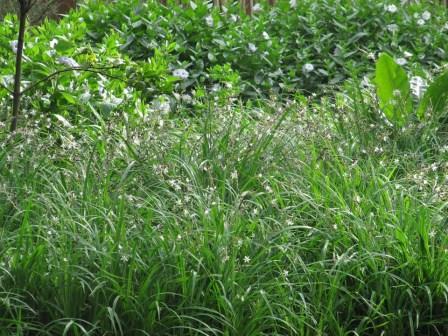 Chlorophytum saundersiae makes a good groundcover. Picture courtesy Random Harvest NurseryIn its natural range Chlorophytum saundersiae is an evergreen perennial, and will not die back during the winter months. It is a gregarious plant which loves to grow in groups or colonies, spreading continually to form thick stands or clumps. The plant grows up to 40cm tall with a spread of 30cm, with a bushy grass-like appearance.
Chlorophytum saundersiae makes a good groundcover. Picture courtesy Random Harvest NurseryIn its natural range Chlorophytum saundersiae is an evergreen perennial, and will not die back during the winter months. It is a gregarious plant which loves to grow in groups or colonies, spreading continually to form thick stands or clumps. The plant grows up to 40cm tall with a spread of 30cm, with a bushy grass-like appearance.
The beautiful weeping sprays of pure white star-shaped flowers have prominent elongated yellow anthers, and are very recognizable as belonging to the ‘Hen and Chicken’ family (Chlorophytum comosum), but without the little ‘chickens’ this genus is so famous for. Watergras also has long thin roots and does not produce tubers like hen-and-chickens.
The plant generally flowers during summer, from October to March, but in warmer climates it can flower sporadically all year round. The fruit is a small, green to brown, globose capsule containing numerous black, angular seeds. The seeds are spread by wind or birds and germinate readily.
Chlorophytum saundersiae 'Starlight'
 Chlorophytum 'Starlight' Picture courtesy Leafs Nursery'Starlight', also known as 'Variegata' is a highly prized plant, and South African gardeners have embraced this garden hybrid because it is one of a very few variegated plants indigenous to South Africa.
Chlorophytum 'Starlight' Picture courtesy Leafs Nursery'Starlight', also known as 'Variegata' is a highly prized plant, and South African gardeners have embraced this garden hybrid because it is one of a very few variegated plants indigenous to South Africa.
It forms a dense clump of slender grass-like leaves that are flat, up to 10mm wide and 750mm long, growing vertically before arching gracefully at their tips. Multiple lines of variegation run along the entire length of the leaves parallel to the midrib; and in ‘Starlight’ the variegation can range from green and white to a green and a golden cream colour, usually depending on the growing conditions. Another bonus is that less than 0.1% of the plants planted in trial runs reverted back to their original green form.
Flowering time is from early summer right through to early winter, and in warm climates flowers can appear throughout the year, and just like the green form the star-shaped flowers are pure white with prominent yellow anthers.
The flower stalks of starlight are totally ‘albino’ because they are devoid of chlorophyll, and although the plants will produce seed capsules from these white flower stalks, they are completely sterile, and starlight will never become weedy by seeding itself in the garden.
How can I use Chlorophytum saundersiae in the garden?
As well as being easy to grow, low maintenance, and suited to a wide range of growing conditions, this little perennial looks good anywhere and is suited to many garden styles, from wild African grassland to English country cottage. Starlight with its striking variegations is fantastic to brighten up dull areas of the garden, and even the green form will lighten up garden spaces with its lovely white flowers.
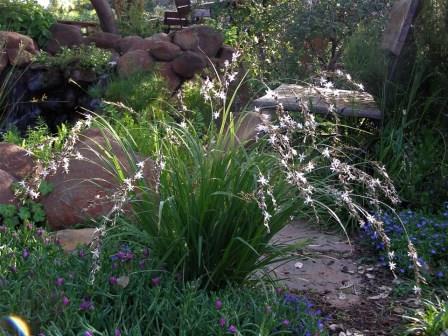 Chlorophytum saundersiae Picture courtesy Random Harvest NurseryBecause it will grow in sun or shade watergrass is particularly useful to plant in those difficult areas of the garden which receive both sun and shade. And an added bonus is the plants will grow in both dry and damp conditions, and are particularly good for dry shade.
Chlorophytum saundersiae Picture courtesy Random Harvest NurseryBecause it will grow in sun or shade watergrass is particularly useful to plant in those difficult areas of the garden which receive both sun and shade. And an added bonus is the plants will grow in both dry and damp conditions, and are particularly good for dry shade.
Watergrass is the perfect ‘filler’ plant for garden beds, and a useful border plant alongside walkways or driveways. It is particularly lovely to add movement and focal points around a water feature or pond. And due to its graceful weeping habit it is also well suited to container plantings. Watergrass is even used on rooftop or balcony gardens, so never underestimate where you can use this remarkable little plant.
Both forms provide excellent structure, contrast and texture to landscapes, and make wonderful groundcovers for large areas, and their foliage and flowers are great companions for other garden plants. Starlight strengthens the colours of flowers planted around it, and both forms contrast well with plants that have dark green, grey, purple, or red leaves.
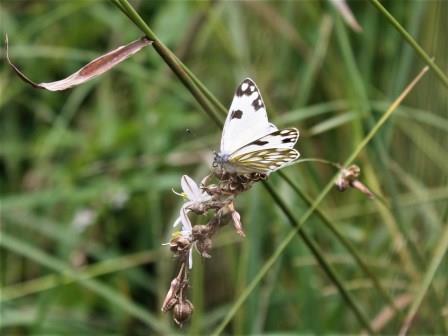 Watergras attracts wildlife to the garden. Picture courtesy Random Harvest NurseryMost delightful of all is the sense of movement and life they bring to the garden with their grassy leaves moving and whispering in even the slightest breeze, and birds, butterflies, bees, and a myriad of other insects flocking to the flowers. Undoubtedly, watergrass is an invaluable asset to all wildlife gardens.
Watergras attracts wildlife to the garden. Picture courtesy Random Harvest NurseryMost delightful of all is the sense of movement and life they bring to the garden with their grassy leaves moving and whispering in even the slightest breeze, and birds, butterflies, bees, and a myriad of other insects flocking to the flowers. Undoubtedly, watergrass is an invaluable asset to all wildlife gardens.
Members can click on highlighted text to read more about the plants mentioned below
Watergras looks wonderful if used together with other indigenous plants to create a natural landscape, and its grass-like texture lends itself to mass plantings, to create a soft, grassland affect. Try combining it with a variety of aloes, other grasses and grass-like species, and spreading groundcovers. Try Gazanias, African Daisies (Dimorphotheca species), Wild Iris (Dietes), Wandflowers (Dierama), and African Potato (Hypoxis).
Watergrass can also be utilised in the light shade on the edge of a manmade forest or woodland garden, together with other indigenous plants like the Forest Bell Bush (Mackaya bella), the River Indigo (Indigofera jucunda) and Spurflowers (Plectranthus). In warmer winter regions, it’s also a great companion for plants like Falling Stars (Crocosmia) which go dormant in winter, as the evergreen watergrass will fill in the gaps when their leaves die back.
How to grow Chlorophytum saundersiae?
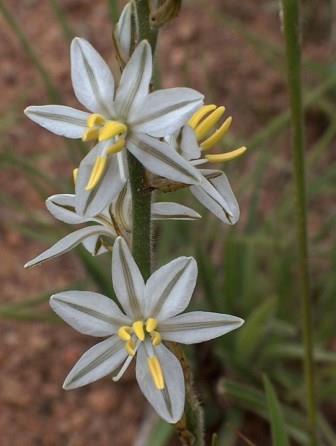 Chlorophytum saundersiae flowers Picture courtesy Random Harvest NurseryIs Chlorophytum saundersiae cold and frost hardy?
Chlorophytum saundersiae flowers Picture courtesy Random Harvest NurseryIs Chlorophytum saundersiae cold and frost hardy?
Both Chlorophytum saundersiae and 'Starlight' are pretty hardy and are completely unaffected by a light to medium frost, but severe frost will burn the leaves. And although consistently low temperatures will result in the plant dying down completely, it will survive temperatures as low as -5°C if the roots are mulched to keep them warm, and the plant is not overwatered in winter. And, as the weather warms up in spring, the plant will quickly re-sprout and grow again.
What type of soil does Chlorophytum saundersiae require?
Watergras will adapt to most fertile garden soils, even clay, but seems to prefer sandy soil with lots of compost. Because it likes a nutrient rich medium, adding generous amounts of compost to the planting holes or beds, together with a balanced garden fertiliser will be sufficient to get your plants off to a good start.
Do I need to fertilise Chlorophytum saundersiae?
If your plants are growing in fertile soil, an annual mulch with a fresh layer of compost should suffice, but if you wish you can also feed in spring with any balanced garden fertiliser.
How often must I water Chlorophytum saundersiae?
Watergrass will withstand drought by going semi-dormant, so to keep it looking great water moderately during long hot and dry spells.
Can I cut down Chlorophytum saundersiae if it becomes untidy?
The plants tend to look untidy at the end of winter, a bit dry and scraggly with tatty with brown tips, and they should be cut down to about 5cm above ground level in early spring. If you have massed beds you can even use a weed eater for the job. A good general purpose fertiliser can also be applied at this time, together with a fresh layer of mulch.
How to propagate Chlorophytum saundersiae?
Chlorophytum saundersiae seeds itself very easily by wind and birds, and the bright green leaves of newly seeded plants will often be found around the garden. They are not a problem to control, and you can simply lift and replant them wherever you want them, or you can give them away to family or friends. Plants grown from seed will flower within one year after being sown.
Starlight produces seeds but they are sterile and will not produce baby seedlings.
Is Chlorophytum saundersiae pest and disease resistant?
This plant needs little in the way of maintenance, and because it is pest and disease resistant, is perfect for gardeners who do not wish to use harmful sprays in their gardens.
Is Chlorophytum saundersiae toxic for humans or pets?
Chlorophytum saundersiae is not poisonous, and pet owners may find that some cats like to eat the leaves for digestion.



